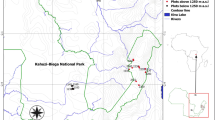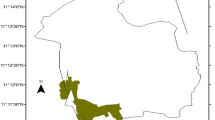Abstract
Plant species distributions show patterns along elevation gradients. Regardless of the diverse Afromontane vegetation in Ethiopia (AFE), studies of elevation patterns of woody plants are limited and they are restricted to small areas or single/few Mountains. Moreover, there is no general consensus on the patterns of woody taxa distribution by elevation. The objectives of this study were to examine the elevation patterns of woody taxa richness and their relationship with elevation in the AFE. Data were collected and compiled from the Flora of Ethiopia and Eritrea (Vols. 1–7). About 5918 plant species of 243 families were examined and their elevational distributions were recorded. The distributional ranges of woody taxa were aggregated at 19 points (sites) at 100 m intervals starting from 1500 to 3400 m a.s.l. Single-factor analysis of variance (one-way ANOVA) was used to test the hypothesis that mean species richness of woody taxa decreases from the lower to the upper limit of AFE. Simple linear correlation and regression were used to show the relationships of woody taxa richness with elevation. We documented the presence of 505 woody taxa (441 species, 31 subspecies and 33 varieties) representing 267 genera and 90 families in the AFE. In terms of habit, 279 taxa are shrubs, 178 are trees and 48 are lianas. The distribution of woody taxa (trees, shrubs and lianas) showed a slight increase at the lower portion and a monotonic decline with increasing elevation. Species richness of trees, shrubs and lianas was negatively and significantly correlated with elevation (r = −0.985, −0.984, −0.981, respectively; all p < 0.001). Our hypothesis was accepted because mean richness significantly decreased from the lower to the upper limit of AFE (p < 0.001). Generally, monotonic patterns of decline in richness were observed for trees, shrubs and lianas. The contribution of shrubs to total richness increased with increasing elevation whereas that of trees and lianas decreased.






Similar content being viewed by others
References
Austin MP (1980) Searching for a model for use in vegetation analysis. Vegetatio 42(1):11–21. doi:10.1007/BF00048865
Aynekulu E (2011) Forest diversity in fragmented landscapes of northern Ethiopia and implications for conservation. Ph.D. Dissertation University of Bonn, Bonn, pp 1–132
Barry RG (2008) Mountain weather and climate. Cambridge University, Cambridge, pp 1–506
Bekele T (1993) Vegetation ecology of remnant Afromontane forests on the central plateau of Shewa, Ethiopia. Ph.D. Dissertation, Uppsala University, Uppsala, pp 1–64
Berhanu A (2015) Endemic plant taxa within the Afromontane vegetation in Ethiopia: implications for plant biodiversity conservation. Addis Ababa University, Addis Ababa, pp 1–22
Brown JH, Lomolino MV (1998) Biogeography (2nd edn). Courier Companies, Sunderland, pp 1–704
Cox CB, Moore PD (2005) Biogeography: an ecological and evolutionary approach, 7th edn. Blackwell, Oxford, pp 1–440
Demissew S, Friis I (2009) Natural vegetation of the Flora Area. In: Hedberg I, Friis I, Persson E (eds) Flora of Ethiopia and Eritrea vol 8. General part and index to vols 1–7. The National Herbarium, Addis Ababa and Uppsala, pp 27–32
Denu D (2006) Floristic composition and ecological study of Bibita forest (Gura Ferda), southwest Ethiopia. MSc. Thesis, Addis Ababa University, Addis Ababa, pp 1–83
Edwards S, Tadesse M, Hedberg I (eds) (1995) Flora of Ethiopia and Eritrea. Cannelaceae to Euphorbiaceae, vols 2-2. The National Herbarium, Addis Ababa and Uppsala, pp 1–456
Edwards S, Demissew S, Hedberg I (eds) (1997) Flora of Ethiopia and Eritrea. Hydrocharitaceae to Arecaceae, vol 6. The National Herbarium, Addis Ababa and Uppsala, pp 1–586
Edwards S, Demissew S, Tadesse M, Hedberg I (eds) (2000) Flora of Ethiopia and Eritrea. Magnoliaceae to Flacourtiaceae, vols 2-1. The National Herbarium, Addis Ababa and Uppsala, pp 1–532
Friis I (1986) The forest vegetation of Ethiopia. Acta Universitatis Upsaliensis Symbolae Botanicae Upsaliensis XXVI:31–47
Friis I (1992) Forests and forest trees of northeast tropical Africa. Kew Bull Addit Ser 15:1–396
Friis I, Demissew S, Breugel PV (2010) Atlas of the potential vegetation of Ethiopia. The Royal Danish Academy of Sciences and Letters, Natural habitats, pp 1–307
Gentry AH (1988) Changes in plant community diversity and floristic composition on environmental and geographical gradients. Ann Mo Bot Gard 75(1):1–34
González AS, Lopez-Mata L (2005) Plant species richness and diversity along an altitudinal gradient in the Sierra Nevada, Mexico. Divers Distrib 11(6):567–575
Grytnes JA, Vetaas OR (2002) Species richness and altitude: a comparison between null models and interpolated plant species richness along the Himalayan altitudinal gradient, Nepal. Am Nat 159(3):294–304
Hedberg I (2009) The Ethiopian flora project—an overview. In: Hedberg I, Friis IB, Persson E (eds) Flora of Ethiopia and Eritrea, vol 8. The National Herbarium, Addis Ababa and Uppsala, pp 1–331
Hedberg I, Edwards S (eds) (1989) Flora of Ethiopia and Eritrea Pittosporaceae to Araliaceae, vol 3. The National Herbarium, Addis Ababa and Uppsala, pp 1–659
Hedberg I, Edwards S, Nemomissa S (eds) (2003) Flora of Ethiopia and Eritrea. Apiaceae to Dipsacaceae vols 4-1. The National Herbarium, Addis Ababa and Uppsala, pp 1–352
Hedberg I, Friis I, Edwards S (eds) (2004) Flora of Ethiopia and Eritrea. Asteraceae (Compositae), vols 4-2. The National Herbarium, Addis Ababa and Uppsala, pp 1–408
Hedberg I, Kelbessa E, Edwards S, Demissew S, Persson E (eds) (2006) Flora of Ethiopia and Eritrea. Gentianaceae to Cyclocheilaceae, vol 5. The National Herbarium, Addis Ababa and Uppsala, pp 1–690
Hedberg I, Friis I, Persson E. (eds) (2009) Flora of Ethiopia and Eritrea vol 8. General part and index to Vols 1-7. The National Herbarium, Addis Ababa and Uppsala, pp 1–331
Henrik BH, Jon M, Risto V, John-Arvid G, Lauri O, Anders A (2006) Effects of altitude and topography on species richness of vascular plants, bryophytes and lichens in alpine communities. J Veg Sci 17:37–46
Jiménez-Castillo M, Wiser SK, Lusk C (2006) Elevational parallels of latitudinal variation in the proportion of lianas in woody floras. J Biogeogr 34(1):163–168
Kebede M, Yirdaw E, Luukkanen O, Lemenih M (2013) Plant community analysis and effect of environmental factors on the diversity of woody species in the moist Afromontane forest of Wondo Genet, south central Ethiopia. Biodiv Res Conserv 29:63–80
Kharkwal G, Mehrotra P, Rawat YS, Pangtey YPS (2007) Phytodiversity and growth form in relation to altitudinal gradient in the central Himalayan (Kumaun) region of India. Curr Sci 89(5):873–878
Lomolino MV (2001) Elevation gradients of species-density: historical and prospective views. Glob Ecol Biogeogr 10:3–13
McCain CM (2007) Could temperature and water availability drive elevational species richness patterns? A global case study for bats. Glob Ecol Biogeogr 16:1–13
McCain CM, Grytnes JA (2010) Elevational gradients in species richness. In: Encyclopedia of life sciences (ELS). Wiley, Chichester. doi: 10.1002/9780470015902
Pinokiyo A, Singh KP, Singh JS (2008) Diversity and distribution of Lichens in relation to altitude within a protected biodiversity hot spot, north-east India. Lichenologist 40(1):47–62
Rahbek C (2005) The role of spatial scale and the perception of large-scale species-richness patterns. Ecol Lett 8:224–239
Ren H, Niu S, Zhang L, Ma K (2007) Distribution of vascular plant species richness along an elevational gradient in the Dongling Mountains, Beijing, China. J Integr Plant Biol 48(2):153–160
Rowe RJ, Lidgard S (2008) Elevational gradients and species richness: do methods change pattern perception. Glob Ecol Biogeogr 18:163–177
Rutten G, Ensslin A, Hemp A, Fischer M (2015) Vertical and horizontal vegetation structure across natural and modified habitat types at Mount Kilimanjaro. PLoS ONE 10(9):1–15
Sanders NJ, Rahbek S (2012) The patterns and causes of elevational diversity gradients. Ecography 35:1–3. doi:10.1111/j.1600-0587.2011.07338.x
Sanders NJ, Moss J, Wagner D (2003) Patterns of ant species richness along elevational gradients in an arid ecosystem. Glob Ecol Biogeogr 12:93–102
Schmitt CB, Denich M, Demissew S, Friis I, Boehmer HJ (2009) Floristic diversity in fragmented Afromontane rainforests: altitudinal variation and conservation importance. Appl Veg Sci 13:291–304
Sharma CM, Suyal S, Gairola S, Ghildiyal SK (2009) Species richness and diversity along an altitudinal gradient in moist temperate forest of Garhwal Himalaya. J Am Sci 5(5):119–128
Shimono A, Zhou H, Shen H, Hirota M, Ohtsuka T, Tang Y (2010) Patterns of plant diversity at high altitudes on the Qinghai-Tibetan Plateau. J Plant Ecol 3(1):1–7
R Core Team (2015) R: a language and environment for statistical computing. R Foundation for Statistical Computing, Vienna. http://www.R-project.org
Teketay D, Bekele T (1995) Floristic composition of Wof-Washa natural forest, central Ethiopia: implications for the conservation of biodiversity. Feddes Repert 106:127–147
Toledo-Garibaldi M, Williams-Linera G (2014) Tree diversity patterns in successive vegetation types along an elevation gradient in the mountains of eastern Mexico. Ecol Res 29(6):1097–1104
Tu W, Gao X, Wu N, Liu S (2010) Altitudinal patterns of vascular plant richness in high mountains: applying of generative additive model. Pol J Ecol 58(2):231–240
Wana D (2009) Plant species and functional diversity along altitudinal gradients, southwest Ethiopian highlands. Ph.D. Dissertation, Bayreuth University, Bayreuth, pp 1–139
Woldu Z (1999) Forests in the vegetation types of Ethiopia and their status in the geographical context. In: Edwards S, Demissie A, Bekele T, Haase G (eds) Forest genetic resources conservation: principles, strategies and actions. Proceedings of the national forest genetic resources conservation strategy development workshop. Institute of Biodiversity Conservation and Research, Addis Ababa, pp 1–38
Yoda K (1967) A preliminary survey of the forest vegetation of eastern Nepal. II. General description, structure and floristic composition of sample plots chosen from different vegetation zones. J Coll Arts Sci 5:99–140
Yu H, Saprunoff M (2012) Distribution of plant species richness along elevation gradient in Hubei Province, China. International Institute for Earth System Science, Nanjing University, Nanjing, pp 378–386
Acknowledgements
We would like to thank the National Herbarium and Ethiopian Biodiversity Institute for availing various resources. All expenses of the first author were covered by the Ethiopian Biodiversity Institute. Anonymous reviewers are also highly acknowledged for their comments and suggestions.
Author information
Authors and Affiliations
Corresponding author
Additional information
Project funding: This work was supported by the Ethiopian Biodiversity Institute.
The online version is available at http://www.springerlink.com
Corresponding editor: Zhu Hong
Rights and permissions
About this article
Cite this article
Berhanu, A., Woldu, Z. & Demissew, S. Elevation patterns of woody taxa richness in the evergreen Afromontane vegetation of Ethiopia. J. For. Res. 28, 787–793 (2017). https://doi.org/10.1007/s11676-016-0350-y
Received:
Accepted:
Published:
Issue Date:
DOI: https://doi.org/10.1007/s11676-016-0350-y




